Electricity Market
Electricity market mechanism design
(1) Market mechanisms to address the curtailment of renewable energy
A new round of electricity market reform has been carried out by the Chinese government. China is suffering high renewable energy curtailment rate, some provinces even exceed 30%. The issue of renewable energy curtailment should be carefully considered in the market mechanism design. One of the main reasons of the curtailment is the inverse distribution between energy resources and load demands. To address it, a mechanism design of national renewable energy market (NREM) with Renewable Portfolio Standard is proposed to incent demand and supply of renewable energy. The other one of the main reasons of the curtailment is lacking of flexibility, primarily due to the limited dispatchable range of thermal generators. A new constraint relaxation-based day-ahead market mechanism is proposed to expand the dispatchable range of generators to promote the accommodation of renewable energy. The trade-off between thermal units and renewable energy is achieved via the market mechanism. Deep ramp offers and curtailment relief bids are proposed to express market participants’ willingness for deep ramp and relieving curtailment.
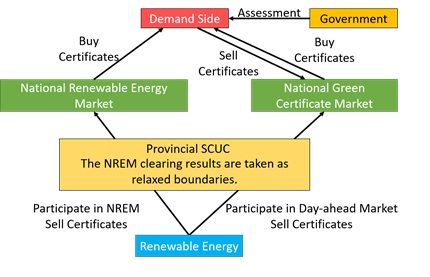 |
|
The mechanism design of national renewable energy market.
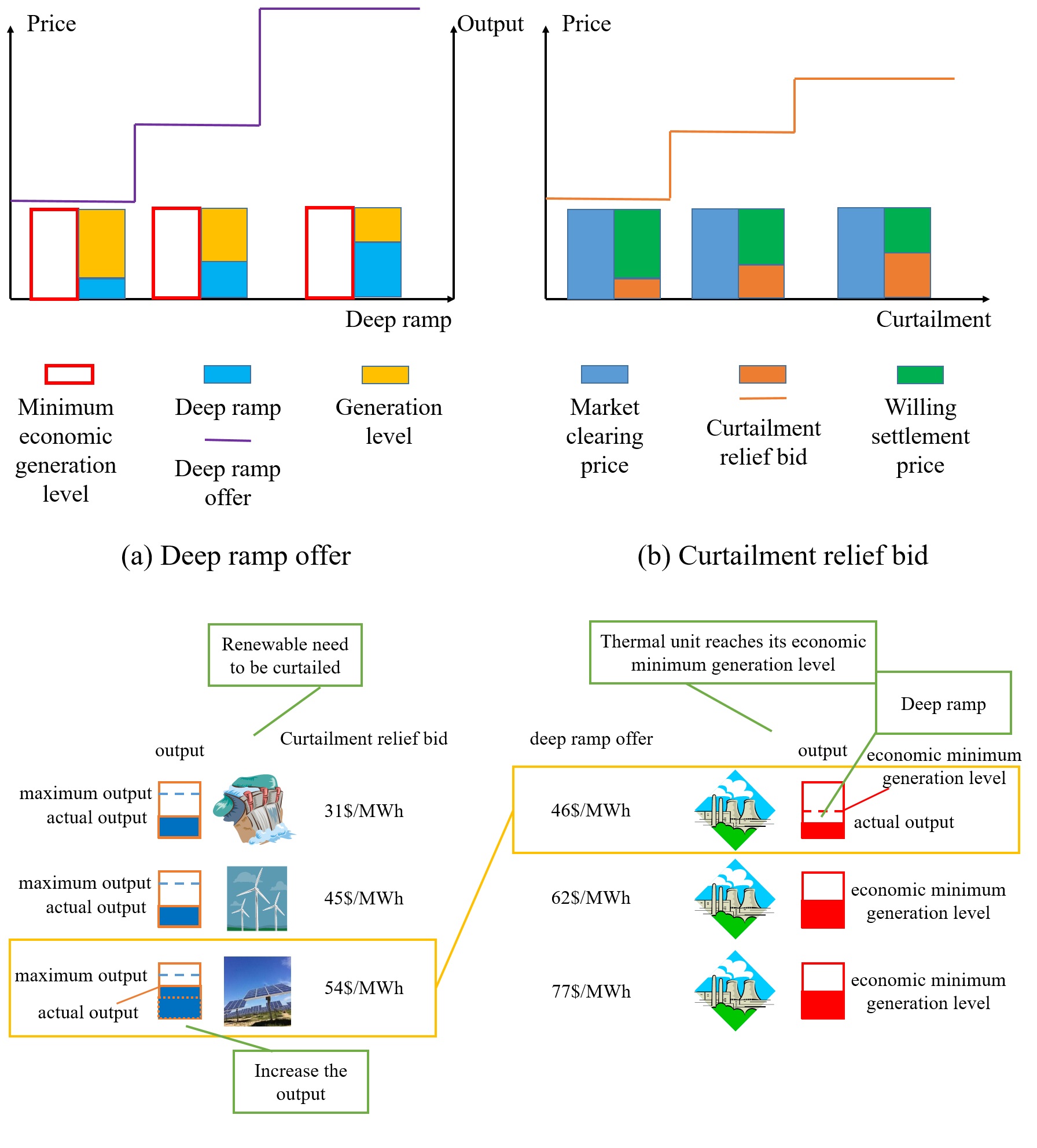 |
|
Constraint relaxation-based day-ahead market mechanism.
(2) Energy Sharing Mechanism
To improve the controllability and utilization of ubiquitous distributed energy resources (DERs), the concept of energy sharing has been advocated as a promising solution. Distinguished from the existing literature considering energy sharing in a non-cooperative game, an energy sharing scheme in a cooperative setting is presented, and an incentive mechanism is designed. In the energy sharing scheme, electricity consumers can flexibly share DERs with each other without bidding on electricity prices. Then consumers’ net load demands are aggregated by an aggregator to trade with the connected power grid. The aggregator is aimed at minimizing the total costs by matching the surplus energy from DERs and electrical loads. A novel index, termed as sharing contribution rate (SCR), is presented to evaluate different users’ contributions to the energy sharing. Then, based on users’ SCRs, an efficient benefit allocation mechanism is implemented to
determine the aggregator's payments to users that incentivize their participation in energy sharing. To avoid users’ bidding, we propose a decentralized framework for the energy sharing and incentive mechanism.
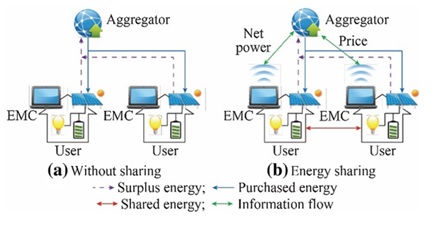 |
|
Decentralized Framework for Energy Sharing
References
Ziming Ma, Haiwang Zhong, Zhenfei Tan, et al. Incenting Demand and Supply of Renewable Energy with Renewable Portfolio Standard:Mechanism Design of National Renewable Energy MarketJ. Automation of Electric Power Systems, 2017.
Shu C , Zhong H , Xia Q , et al. Monthly electricity market design based on constraint relaxationJ. Proceedings of the Csee, 2016.
Ziming Ma, Haiwang Zhong, Qing Xia, et al. Constraint Relaxation-based Day-ahead Market Mechanism Design to Promote the Accommodation of Renewable Energy J. Energy, (under review).
Jianxiao Wang, Haiwang Zhong, et al. Incentive mechanism for cooperative energy sharingC. 2018 IEEE Power & Energy Society General Meeting (PESGM). IEEE, 2018.
Jianxiao Wang, Haiwang Zhong, et al. Incentive mechanism for sharing distributed energy resourcesJ. Journal of Modern Power Systems and Clean Energy (2019): 1-14.
Jianxiao Wang, Haiwang Zhong, et al. Incentivizing distributed energy resource aggregation in energy and capacity markets: An energy sharing scheme and mechanism designJ. Applied Energy 252 (2019): 113471.
Market clearing algorithm
(1) Unit Commitment algorithm
Unit Commitment (UC) is one of the most critical market clearing algorithms for electricity markets, especially for day-ahead market and mid-long term market planning. The efficiency of large-scale unit commitment (UC) is still a critical issue in power system and electricity market operations. To reduce the computation time of UC, relaxation-based neighborhood search (RBNS) and improved relaxation inducement (IRI) are proposed in this paper. RBNS explores the neighborhood of the linear program (LP) relaxation optimal solution for a high-quality feasible solution. A new distance function, termed relaxation distance (RD), is proposed to measure the distance between the current solution and the tendency of the LP relaxation optimal solution. RBNS can substantially reduce the optimization space, and thus improve the efficiency. IRI has been developed to effectively induce binary variables towards the tendency of the relaxed solution. In contrast to a conventional relaxation inducement method, the binary variables are symmetrically and bidirectionally induced. The numerical ratio between the inducing functions and the original objective function is optimized. IRI can induce more binary variables to integrality, and fewer binary variables need to be branched. Therefore, the size of the branch-and-bound tree can be reduced significantly.
(a)
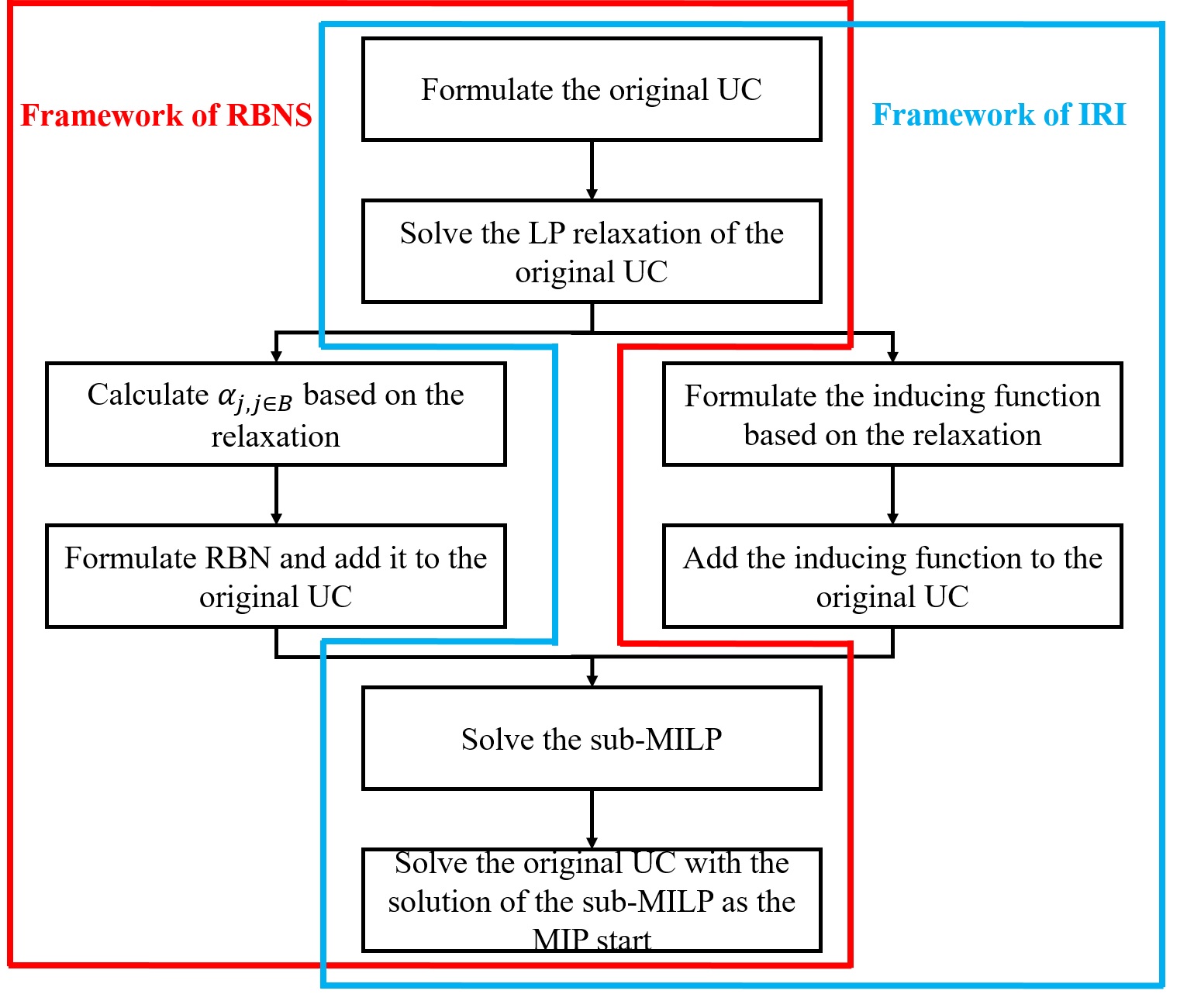 |
|
(b)
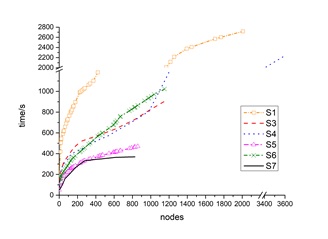 |
|
Relaxation-based neighborhood search (RBNS) and improved relaxation inducement (IRI). (a) is the framework of the proposed SCUC algorithm. (b) is the searching process of different algorithms, in which, S1: Original UC, S2: original RI, S3: RBNS, S4: IRI (1), S5: IRI (10000), S6: RBNS combined with IRI (1), S7: RBNS combined with IRI (10000) (proposed).
(2) Matchmaking based algorithm
In the progress of electricity market reform in China, some unique market clearing algorithms should be developed to address the unique characteristics in China's power industry. Some issues must be carefully considered in the establishment of the power market. A matchmaking based day-ahead market clearing algorithm is proposed, in which daily residual energy quantity is the object of transaction and bidding is based on spread, i.e., the difference compared with the regulated electricity price. To accurately reflect the matchmaking rules and the exact information of the matching-pair, a novel matchmaking algorithm with differentiated weighting coefficients is presented.
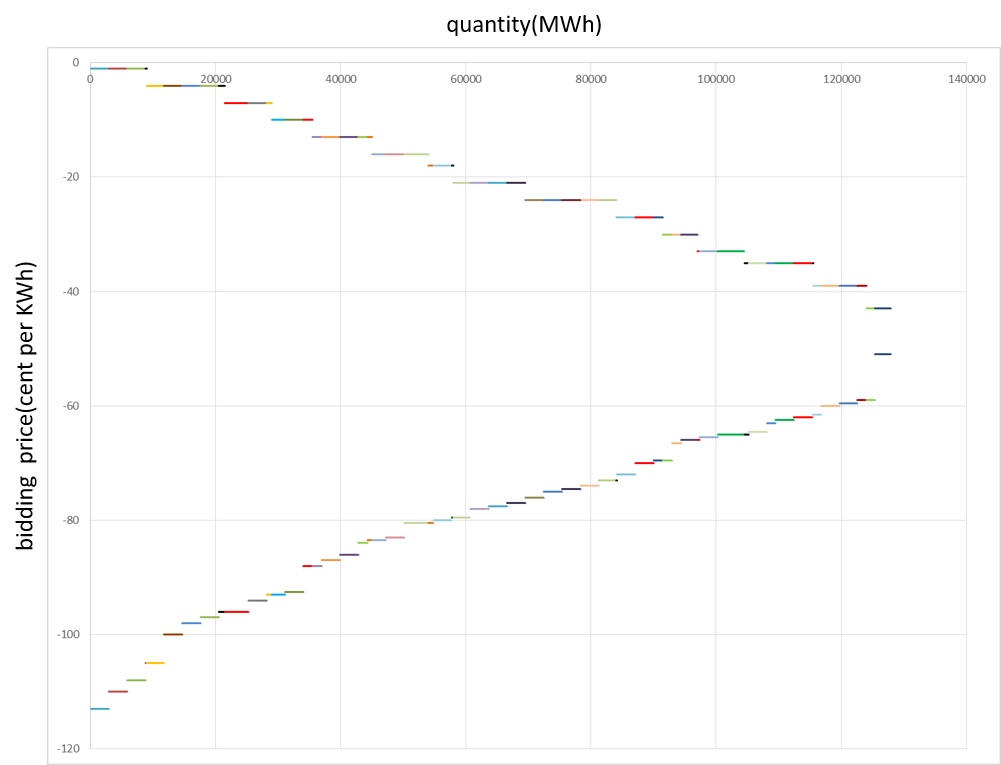 |
|
The matching-pair of the proposed matchmaking algorithm.
References
Ziming Ma, Haiwang Zhong, Qing Xia, et al. A Unit Commitment Algorithm with Relaxation-based Neighborhood Search and Improved Relaxation Inducement J. IEEE Transactions on Power Systems, (under review).
Yang B, Zhong H, Xia Q, et al. Inducing-objective-function-based method for long-term SCUC with energy constraintsJ. International Journal of Electrical Power & Energy Systems, 2014, 63(4):971-978.
Ziming Ma, Haiwang Zhong, et al. A matchmaking based day-ahead market design in ChinaC Innovative Smart Grid Technologies-asia. IEEE, 2016.
Market pricing scheme
(1) Total cost price
In the research of smart grid, people generally pay more attention to the interaction between power source as a means to accommodate more renewable energy, than the 'extent of use’ of the grid by power source and loads. The potential benefit and value of the interaction among power source, grid and load has not been fully developed. An interaction pattern and method of power source, grid and load based on total cost price (TCP) was proposed. For the source side, transmission cost was considered in the economic dispatch. For the load side, a power flow trace method based on TCP was proposed to reveal how the load uses the source and grid. The method reflects the principle of 'he who reaps the benefit bears the cost’. The numerical experiment results show that the proposed method can allocate transmission costs to users according to their 'extent of use’ of the grid. Furthermore the method promotes the high effectiveness, fairness, orderliness and security in power system investment and operations.
 |
|
Power flow comparison between conventional LMP and proposed TCP.
(2) A Linear Model for the Loss-Embedded LMP
The concept of locational marginal price (LMP) is revisited by analyzing the Karush-Kuhn-Tucker (KKT) condition of a general optimal power flow (OPF) problem. The impact of losses on LMP is investigated. Several well-known properties and formulations of the LMP are illustrated from a novel perspective. In particular, the special case of the lossless DC OPF model is discussed. Based on this theoretical analysis, a linear model for the loss-embedded LMP is proposed. The influence of losses on the LMP is recovered by solving a system of linear equations. The proposed method does not rely on strong subjective assumptions, such as the selection of reference buses or the determination of the 'loss factor’.
 |
|
Comparison of results obtained with MI to MIV in the uncongested IEEE 30-bus system.
(3) Transmission pricing scheme
In liberalized electricity markets, it is essential and of great importance to develop a fair transmission cost allocation scheme that is able to reflect the 'extent of use’ of the transmission facilities as much as possible. In the proposed transmission pricing scheme, the transmission capacity is divided into four components: capacity used in normal conditions (CN), capacity reserved for contingencies (CC), capacity reserved for future use (CF) and invalid capacity (IC). CN and CC are determined by the power flow in the normal and contingency conditions of the system operation snapshot, respectively. The CF is determined by the maximum power flow in contingency conditions over a certain period (say yearly). The cost corresponding to IC would not be allocated to network users. Based on capacity usage identification, differential cost allocation methods are designed according to the functions of the transmission capacity. The cost corresponding to the capacity usage of the transmission asset under normal and contingency conditions is allocated separately.
 |
|
Sketch of the transmission capacity identification.
(4) Block-of-use retail pricing
The utilization rate of generation assets significantly affects the profits of generation companies. Since the daily load profiles of customers are not considered in conventional time-of-use (TOU) pricing, a fairness issue may arise because of cross subsidy. To address this issue, a block-of-use (BOU) electricity retail pricing approach is proposed, in which the price varies from block to block instead of varying from period to period. The aggregated daily load profile is horizontally divided into blocks according to the utilization rate of the generation assets. A block filling approach is proposed to allocate the customer load into different blocks. The contribution of each customer’ s load profile to the generation assets can be quantified. A BOU pricing approach is proposed, in which the rate of each block consists of the fixed rate and the variable rate.
(a)
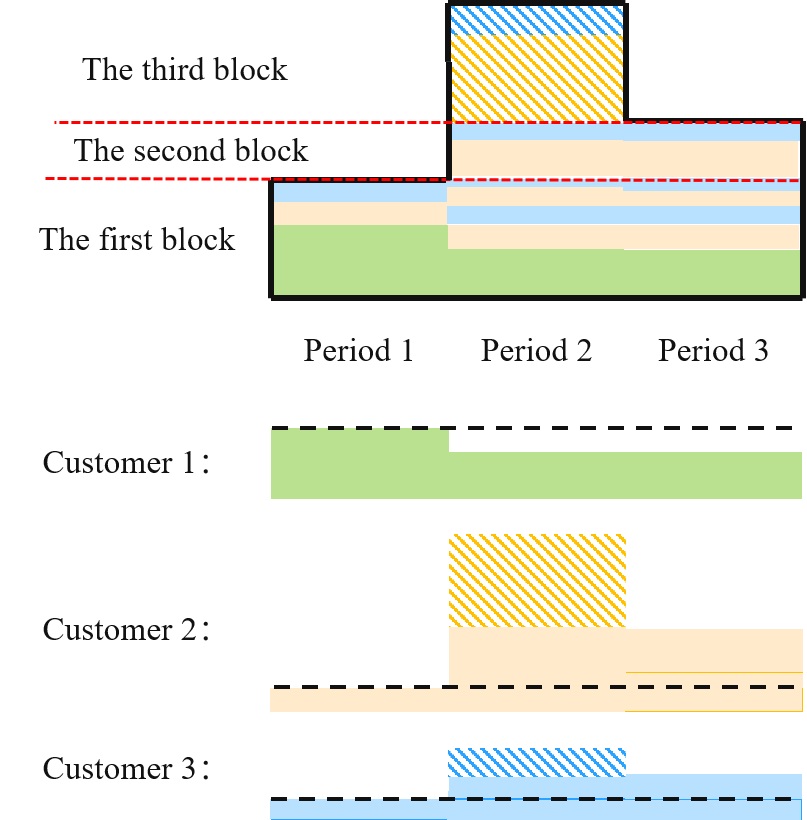 |
|
(b)
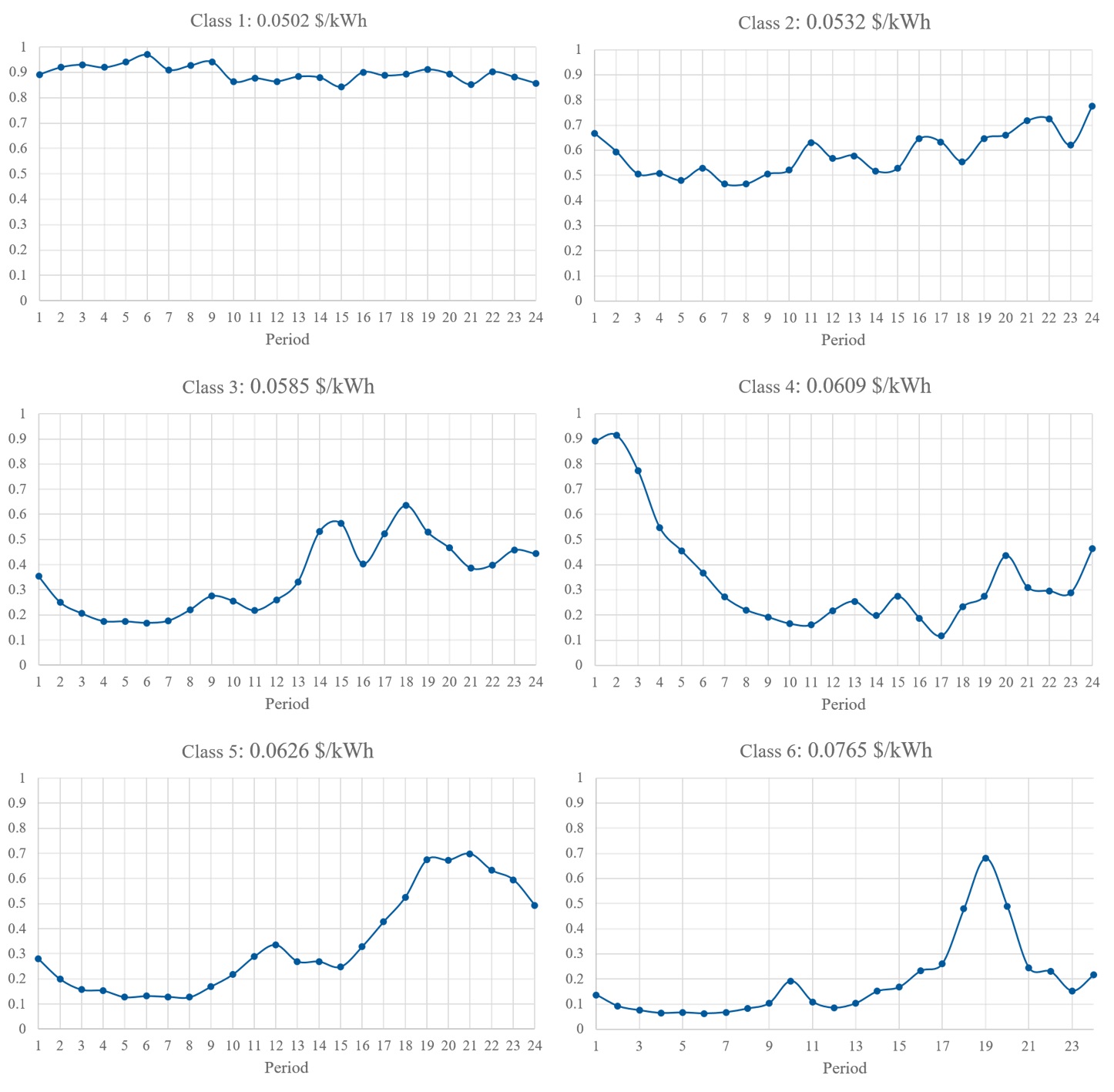 |
|
The proposed BOU approach. (a) is an example of block filling approach. (b) is the cluster center and the average BOU rate of each class.
References
Chen D , Zhong H , Xia Q . Security constrained economic dispatch based on total cost priceJ. Proceedings of the CSEE, 2016.
Dian C , Haiwang Z , Qing X . Coordinated Planning of Generation-Transmission-Consumption Based on Total Cost PriceJ. Power System Technology, 2017.
Yang Z , Bose A , Zhong H , et al. LMP Revisited: A Linear Model for the Loss-Embedded LMPJ. IEEE Transactions on Power Systems, 2017.
Yang, Zhifang, et al. “A structural transmission cost allocation scheme based on capacity usage identification.” IEEE Transactions on Power Systems 31.4 (2015): 2876-2884.
Wang, Jianxiao, et al. “Optimal planning strategy for distributed energy resources considering structural transmission cost allocation.” IEEE Transactions on Smart Grid 9.5 (2017): 5236-5248.
Wang, Jianxiao, et al. “Tri-level expansion planning for transmission networks and distributed energy resources considering transmission cost allocation.” IEEE Transactions on Sustainable Energy 9.4 (2018): 1844-1856.
Ziming Ma, Haiwang Zhong, Qing Xia, et al. A Block-of-use Electricity Retail Pricing Approach based on the Customer Load Profile J. IEEE Transactions on Smart Grid, (under review).
Ma, Ziming, et al. “Customer load profile-based pricing strategy of retailers with generation assets in retail markets.” 2017 IEEE Power & Energy Society General Meeting. IEEE, 2017.
Market price forecasting
(1) LMP price forecasting
LMP forecasting plays a significant role in electricity market. It assists market participants to make reasonable bidding strategies and reduce their potential trading risks and helps system operators in system planning. A graph convolutional network model is proposed for LMP forecasting in the view of market participants. Major existing methods model LMP as time series and adopt classic statistics methods or traditional neural network for LMP forecasting, which only focus on single node's LMP while ignoring the interaction between different nodes. Unlike existing methods that only consider the temporal features of LMP, our proposed method models power system as undirected graph and builds a spectral graph convolutional network to extract the spatial features of LMP. Our network can output LMP of all nodes simultaneously, making up for the defect that traditional neural networks can not accurately restore the spatial information of LMP.
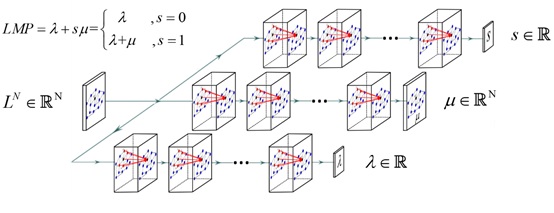 |
|
Framework of the graph convolutional network model.
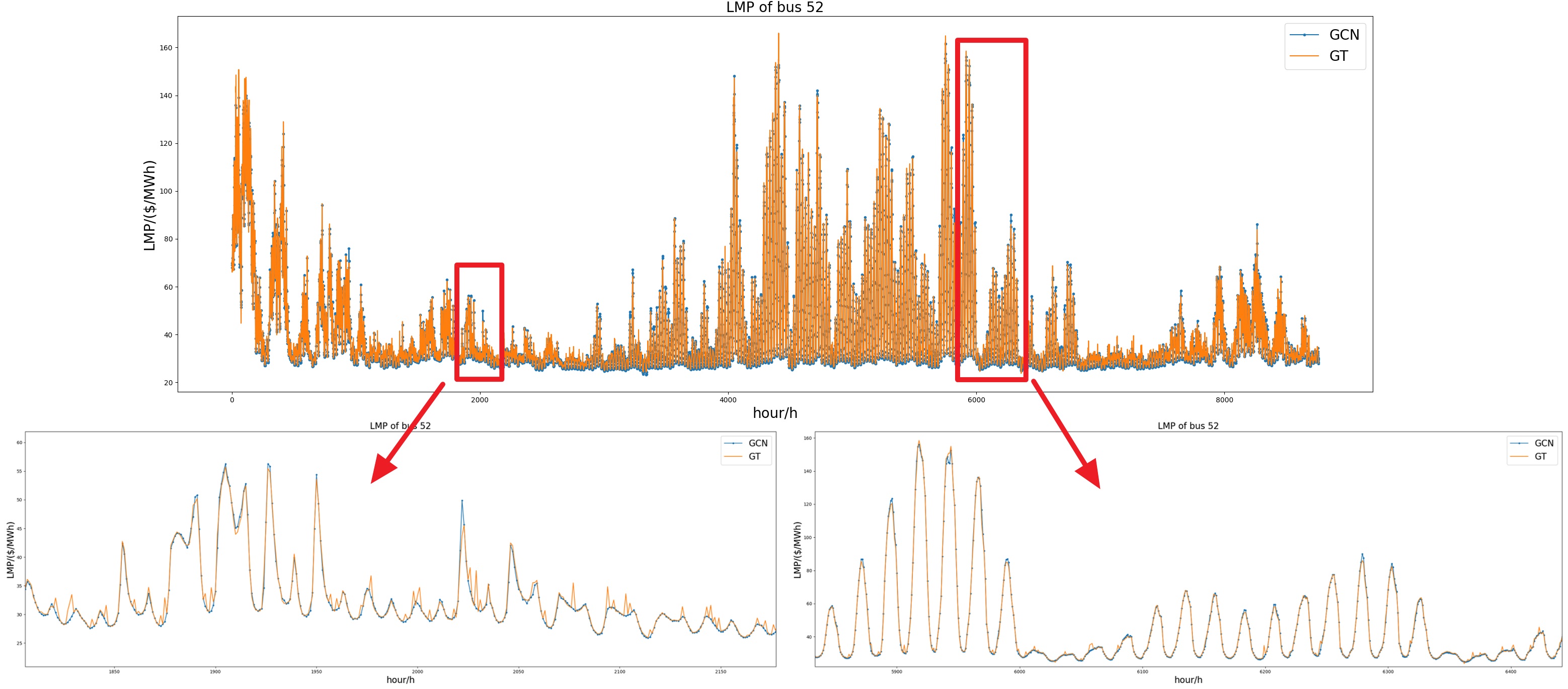 |
|
Results of the proposed methods, in which GCN is the proposed method and GT is the ground truth.
(2) Month ahead average daily electricity price profile forecasting
Month ahead average daily electricity price profile forecasting is proposed for the first time in this paper. A hybrid nonlinear regression and support vector machine (SVM) model is proposed. Offpeak hours, peak hours in peak months and peak hours in off-peak months are distinguished and different methods are designed to improve the forecast accuracy. A nonlinear regression model with deviation compensation is proposed to forecast the prices of off-peak hours and peak hours in off-peak months. SVM is adopted to forecast the prices of peak hours in peak months.
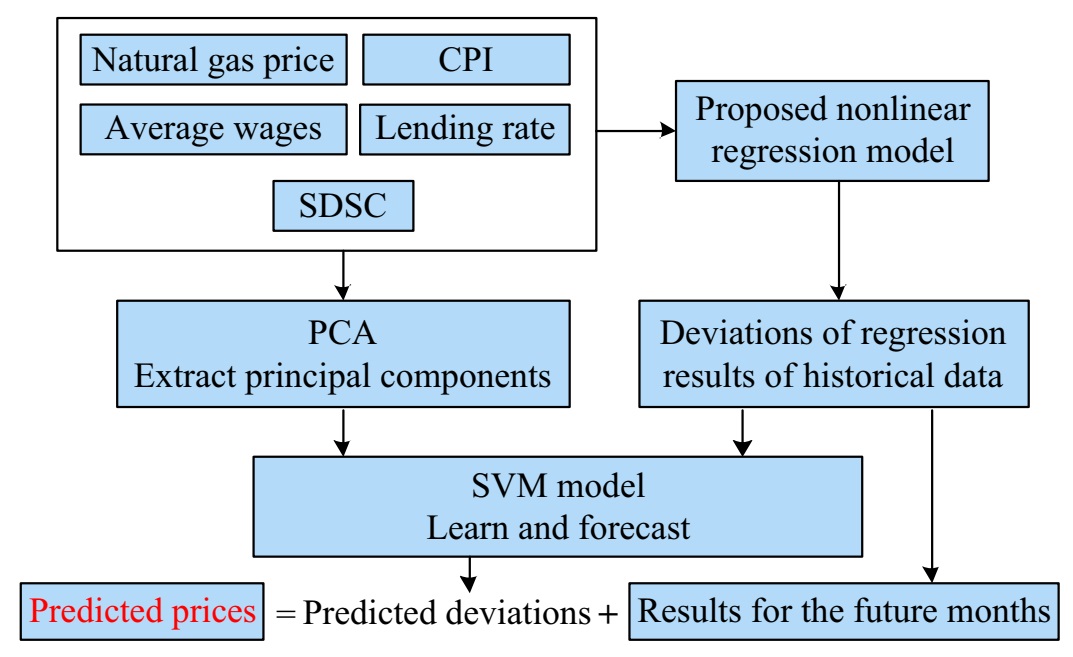 |
|
Framework of hybrid nonlinear regression and SVM model.
 |
|
Forecast results based on hybrid model and a brief comparison with other models.
References
Haitao Yang.LMP Forecasting based on Graph Convolutional NetworkD.Tsinghua University, 2019.
Ma Z , Zhong H , Xie L , et al. Month ahead average daily electricity price profile forecasting based on a hybrid nonlinear regression and SVM model: an ERCOT case studyJ. Journal of Modern Power Systems and Clean Energy, 2018.